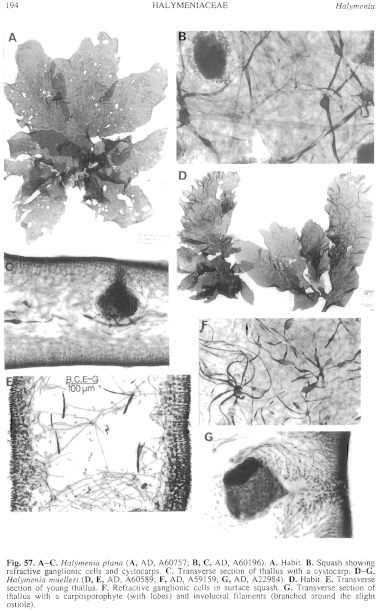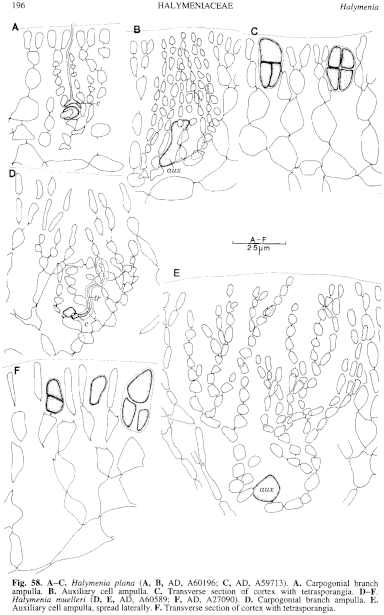|
|
|
|
|
|||||||||||
|
Electronic Flora of South Australia Species Fact Sheet
Phylum Rhodophyta – Class Florideophyceae – Order Gigartinales – Family Halymeniaceae
Selected citations: J. Agardh 1876: 142. De Toni 1905: 1553. Kützing 1866: 34, p1. 95.
Thallus (Fig. 57D) medium to dark red or red-brown, fading to yellow-brown, surface mucilaginous, foliose with the surface usually mottled with small darker and lighter patches, smooth to becoming rugose or bullate, (10–) 15–60 cm high and (5–) 10–25 (–30) cm across, mostly 800–1200 µm thick, divided near the stipe into a few lobes when young, when mature broadly lobed to much divided with 2–3 orders of marginal lobes, margin smooth to slightly undulate and with small tapering ultimate branchlets; stipe cuneate. Holdfast discoid, 2–6 mm across; epilithic. Structure (Fig. 57E) of a cortex (5–) 6–10 (–12) cells broad, the outer in anticlinal rows of 2–5 cells, 2–4 µm in diameter and L/D 3–4 in thallus section, inner cells separated from each other and becoming stellate, mostly 8–16 µm across; medulla lax when young with many filaments crossing transversely and others irregularly; older medulla becoming dense, refractive ganglionic cells (Fig. 57F) common and conspicuous, often with large swellings in the arms. Rhodoplasts discoid to elongate, becoming lobed in inner cells.
Reproduction: Sexual thalli probably dioecious. Carpogonial branch ampullae (Fig. 58D) small, with several secondary filaments, erect to converging above, with a 2-celled carpogonial branch. Auxiliary cell ampullae (Fig. 58E) prominent, becoming cup-shaped to spreading, 60–160 µm across, with numerous secondary filaments, branches of 3–5 orders and the lower cells of the filaments elongating; auxiliary cell prominent; ampullae separating the cortical filaments and thus producing an ostiole. Carposporophyte (Fig. 57G) lying largely within the medulla, 100–140 µm across, with 2–3 lobes, carposporangia more or less isodiametric, 4–6 µm across. Involucre slight to moderate, with prominent upper laterals from the ampullary filaments surrounding a distinct ostiole. Spermatangia not observed.
Tetrasporangia (Fig. 58F) scattered, on mid cells of the outer cortex, 25–35 µm long and 15–20 µm in diameter, cruciately divided.
Type from Lefevre Pen., S. Aust. (Mueller, July 1852); lectotype in MEL, 502396; isolectotype MEL, 502397.
Selected specimens: Elliston, S. Aust., 9 m deep (Shepherd, 27.x.1971; AD, A42435). Snapper Point, Port Lincoln, S. Aust., 6–8 m deep (Baldock, 1.i.1964; AD, A27090). Wedge I., S. Aust., 11 m deep (Baldock, 28.xii.1963; AD, A27234). Cable Hut Bay, Yorke Pen., S. Aust., drift (Womersley, 15.x.1988; AD, A59159). Stenhouse Bay, S. Aust., 3–7 m deep (Kraft, 18.ix.1973; AD, A44560). Off Troubridge Light, S. Aust., 17 m deep (Shepherd, 4.ii.1969; AD, A33442). Marino, S. Aust., drift (Womersley, 26.x.1975; AD, A46640). Port Stanvac, S. Aust., drift (Womersley, 14.x.1972; AD, A42769). Victor Harbor, S. Aust., drift (Womersley, 22.ix.1990; AD, A60589). Vivonne Bay, Kangaroo I., S. Aust., drift (Womersley, 19.xii.1990; AD, A60812). Port MacDonnell, S. Aust., drift (Womersley, 15.iv.1959; AD, A22984 and 20.viii.1984; AD, A55717). Dutton Bay, Portland, Vic., drift (Womersley, 13.iv.1959; AD, A22676).
Distribution: Elliston, S. Aust., to Cape Woolamai, Vic.
Taxonomic notes: Halymenia muelleri appears to be a deep-water alga, superficially resembling H. plana but more lobed and branched than the latter. It also differs in the anticlinal outer cortex, the less pseudoparenchymatous cortex and the broad, open, auxiliary cell ampullae.
Halymenia muelleri Sonder was described from two collections now in MEL, made in July 1852 and Dec. 1847 by F. Mueller. The description referred to both collections, to their colour roseus (1852 collection) which soon became pale (1847 collection), and "fructus deest" (the 1852 collection), the faded 1847 collection being cystocarpic. The 1852 collection is hence chosen as lectotype and isolectotype (a MEL specimen which Sonder did not see), and the 1847 collection (MEL, 502394) as syntypes.
References:
AGARDH, J.G. (1876). Species Genera et Ordines Algarum. Vol. 3, Part 1 - Epicrisis systematis Floridearum, pp. i-vii, 1–724. (Weigel: Leipzig.)
DE TONI, G.B. (1905). Sylloge Algarum omnium hucusque Cognitarum. Vol. 4. Florideae. Sect. 4, pp. 1523–1973. (Padua.)
KÜTZING, F.T. (1866). Tabulae Phycologicae. Vol. 16. (Nordhausen.)
SONDER, O.W. (1853). Plantae Muellerianae. Algae. Linnaea 25, 657–709.
The Marine Benthic Flora of Southern Australia Part IIIA complete list of references.
Publication:
Womersley, H.B.S. (14 January, 1994)
The Marine Benthic Flora of Southern Australia
Rhodophyta. Part IIIA, Bangiophyceae and Florideophyceae (to Gigartinales)
Reproduced with permission from The Marine Benthic Flora of Southern Australia Part IIIA 1994, by H.B.S. Womersley. Australian Biological Resources Study, Canberra. Copyright Commonwealth of Australia.
Illustrations in Womersley Part IIIA, 1994: FIGS 57 D–G, 58 D–F.

Figure 57 enlarge
Fig. 57. A–C. Halymenia plana (A, AD, A60757; B, C, AD, A60196). A. Habit. B. Squash showing refractive ganglionic cells and cystocarps. C. Transverse section of thallus with a cystocarp. D–G. Halymenia muelleri (D, E, AD, A60589; F, AD, A59159; G, AD, A22984). D. Habit. E. Transverse section of young thallus. F. Refractive ganglionic cells in surface squash. G. Transverse section of thallus with a carposporophyte (with lobes) and involucral filaments (branched around the slight ostiole).

Figure 58 enlarge
Fig. 58. A–C. Halymenia plana (A, B, AD, A60196; C, AD, A59713). A. Carpogonial branch ampulla. B. Auxiliary cell ampulla. C. Transverse section of cortex with tetrasporangia. D–F. Halymenia muelleri (D, E, AD, A60589; F, AD, A27090). D. Carpogonial branch ampulla. E. Auxiliary cell ampulla, spread laterally. F. Transverse section of cortex with tetrasporangia.

|
Email Contact: State Herbarium of South Australia |

|